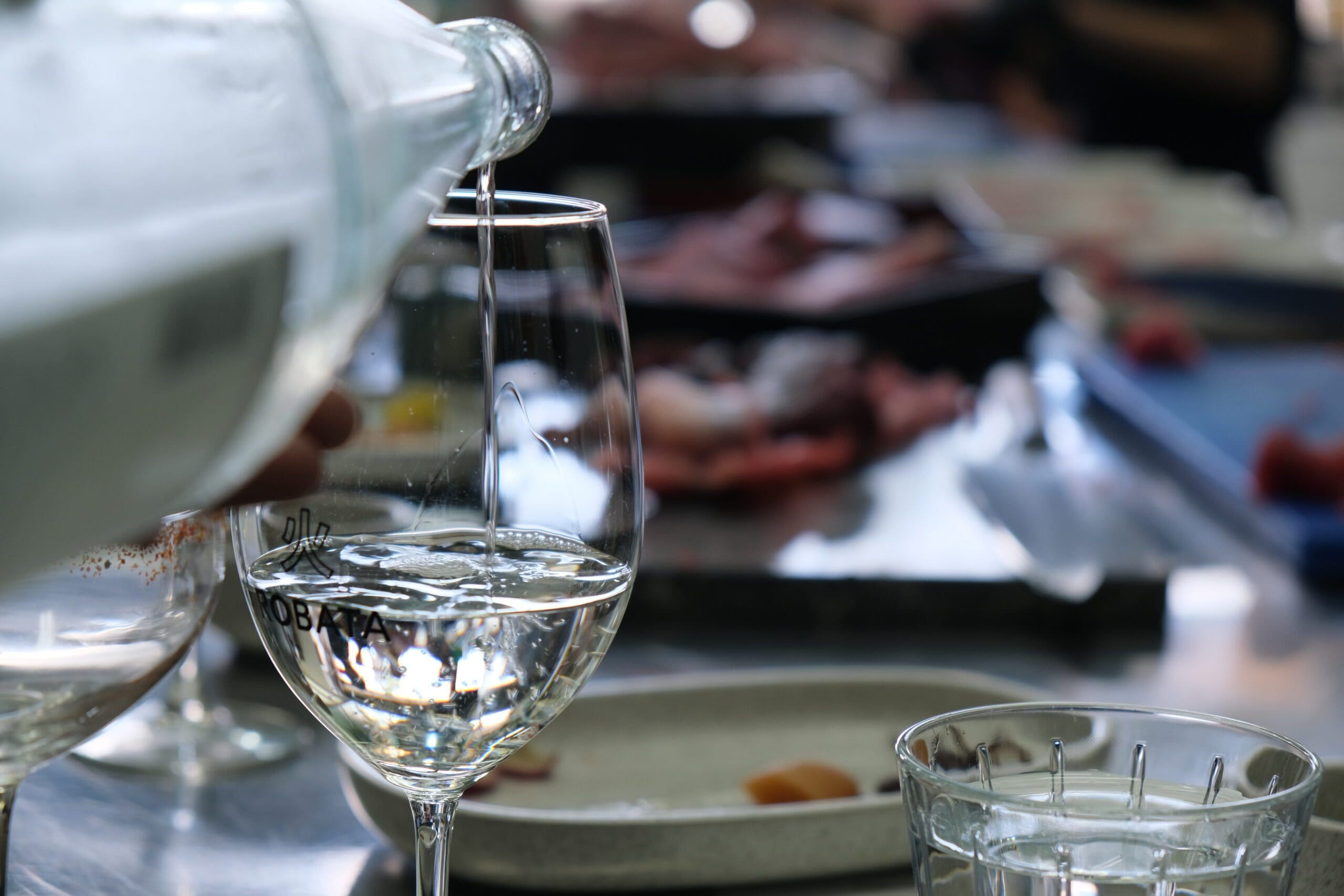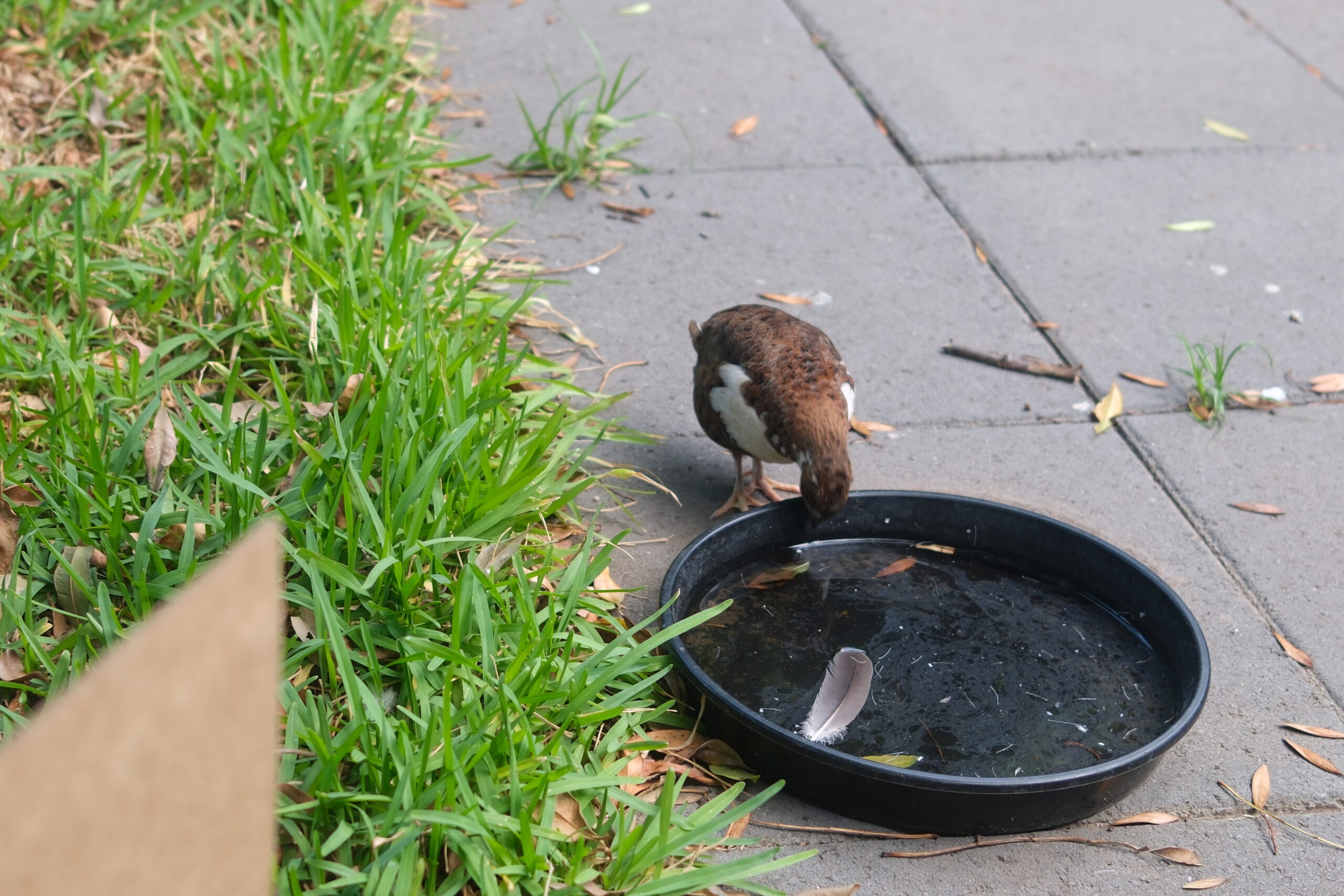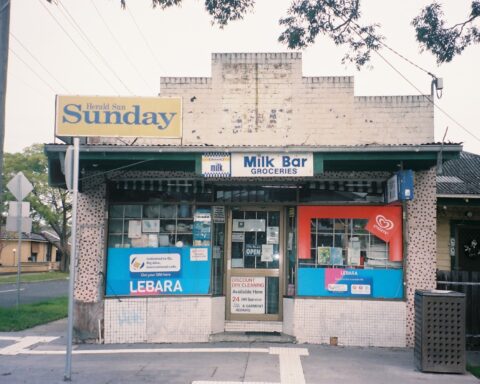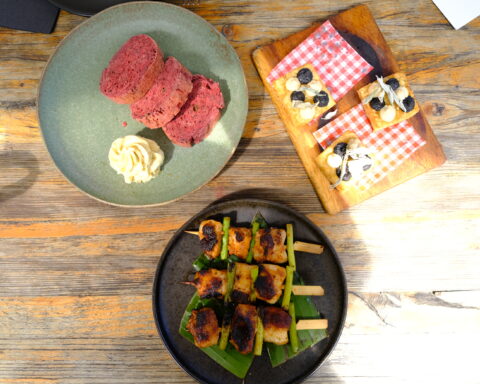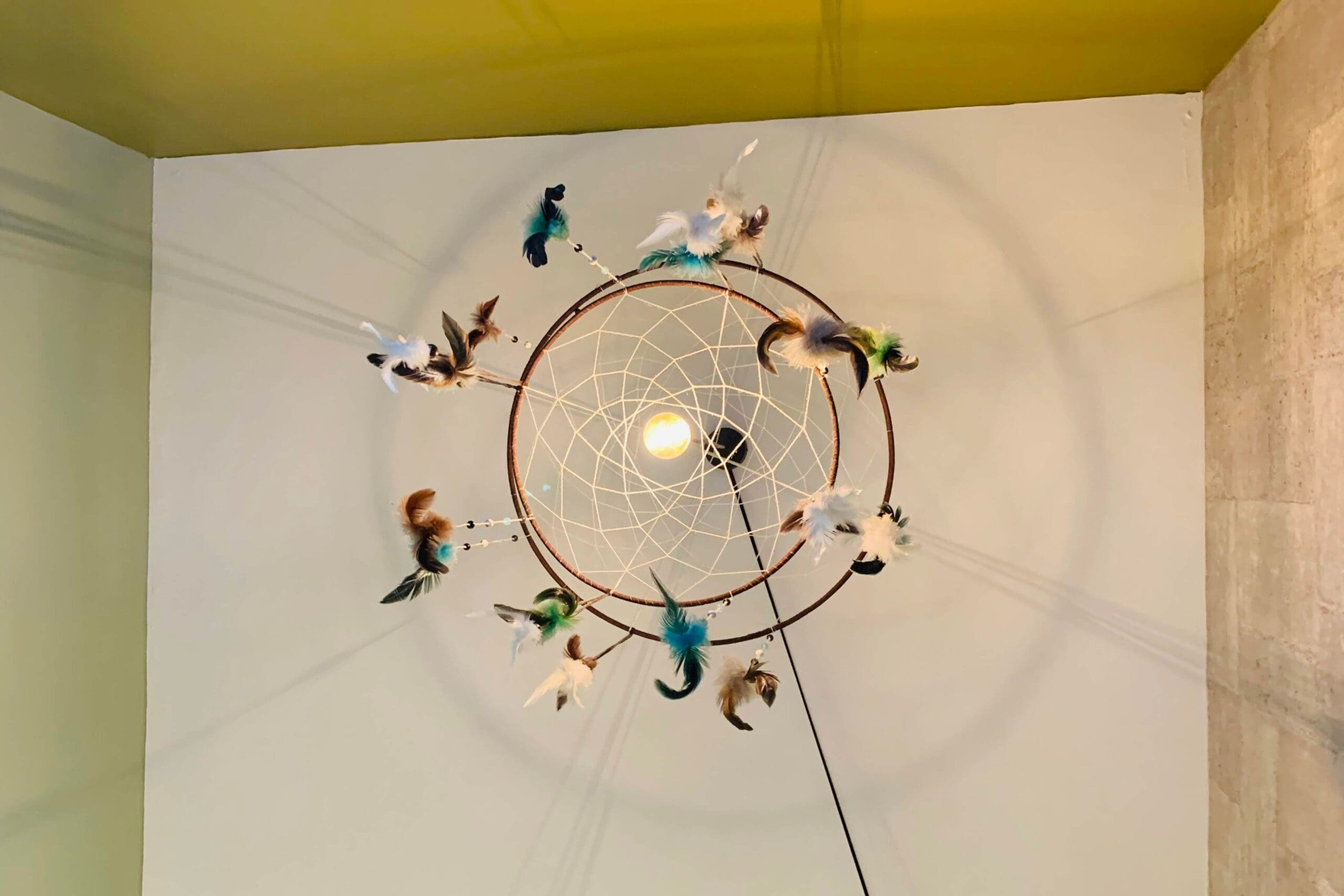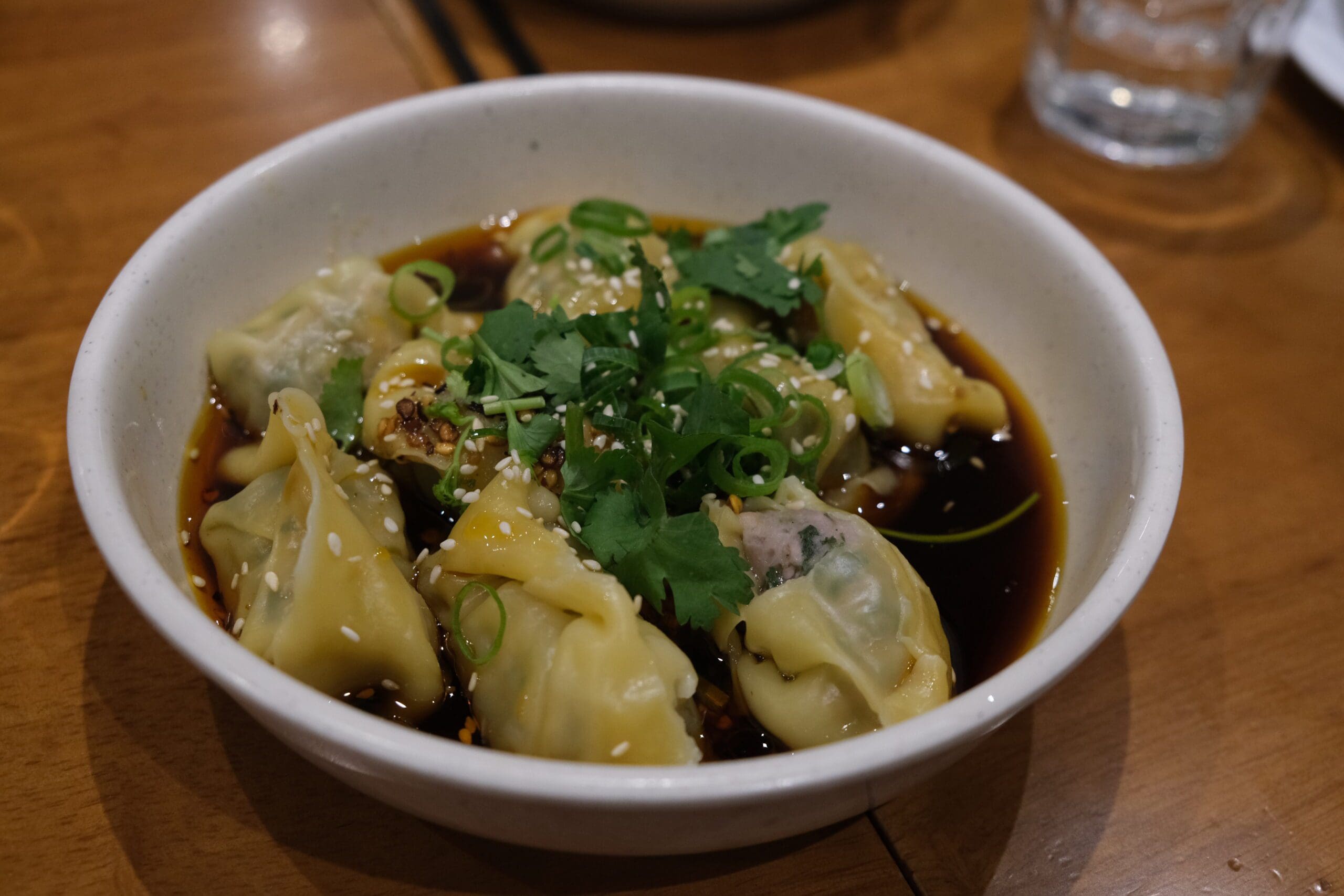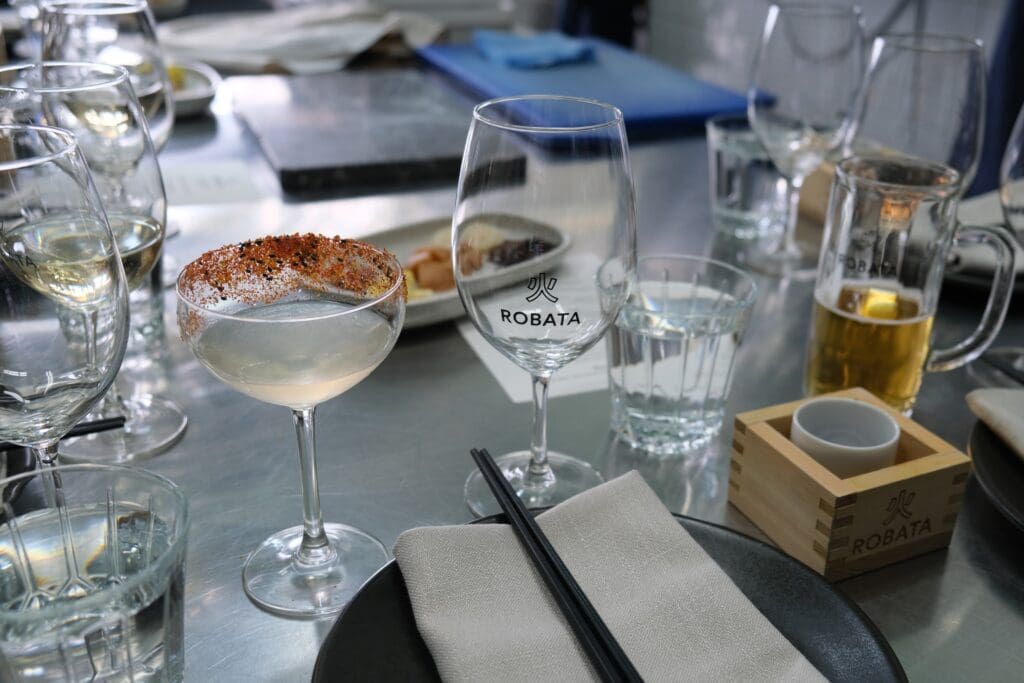
I attended a Japanese cooking masterclass in Robata Melbourne last month to learn the best way to slice tuna ━ from the tail to the head, to maintain the shape and not break the spine. I hadn’t heard about Robata before, but this year I am resolute on doing different things in Melbourne every month. Since I had such a great time during the Korean cooking class, the Japanese cooking masterclass seemed like something I’d enjoy.
Japanese Cooking Masterclass at Robata Melbourne
The Japanese cooking masterclass was held in Robata Melbourne’s test kitchen at 52 Flinders Street. Walking there with my half-drunk Kara-Garita and ten other classmates, I knew I was in for a fun afternoon.
We had a chef, sous-chef and Gema, the resident-Sake-connoisseur waiting to take us through the Japanese cooking masterclass that day.
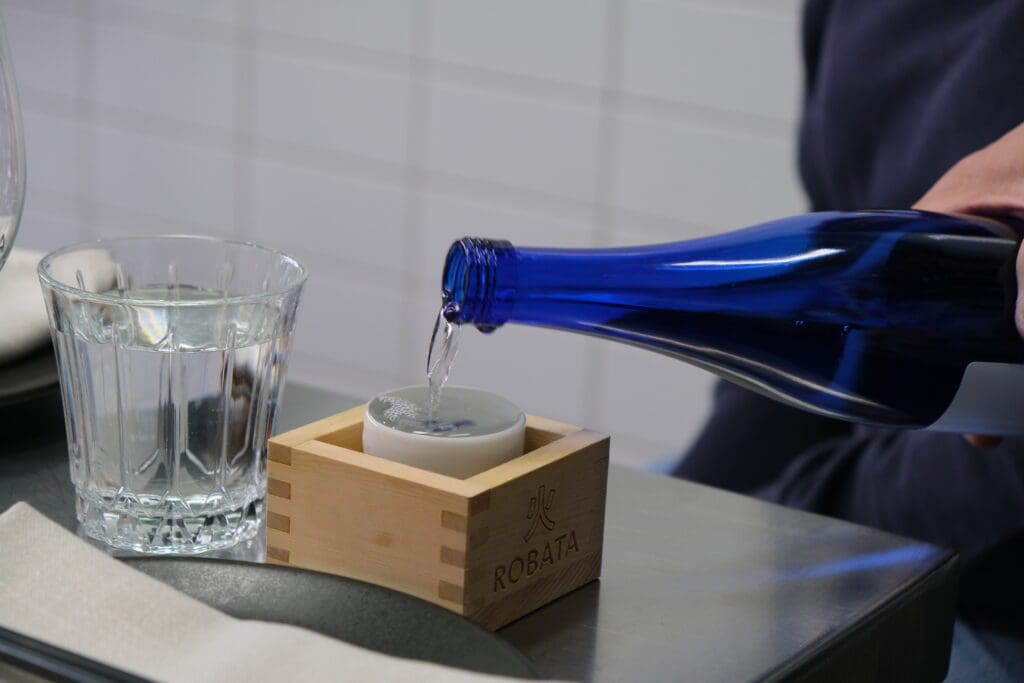
Once seated, we were served overflowing sake ━ a symbol of generosity in Japanese culture. The white and blue patterned Ochoko (sake cup) is typically used while judging sake competitions as it is supposed to aid in seeing the colour and clarity of the sake.
Tokusen Teinoudo Junmai Sake
The Sake itself is called Tokusen Teinoudo Junmai of Hakutsuru ━ White Crane. It came from Nada, Hyogo prefecture (near Kobe). Hyogo region produces the highest volume of Sake in Japan. The underground water found in Nada, known as “miyamizu”, has a high mineral content and is famous for producing high-quality sake that is typically drier, fuller-bodied, umami-driven and acidic with less aromatic intensity. Hence, it is sometimes referred to as “otokozake” or masculine sake.
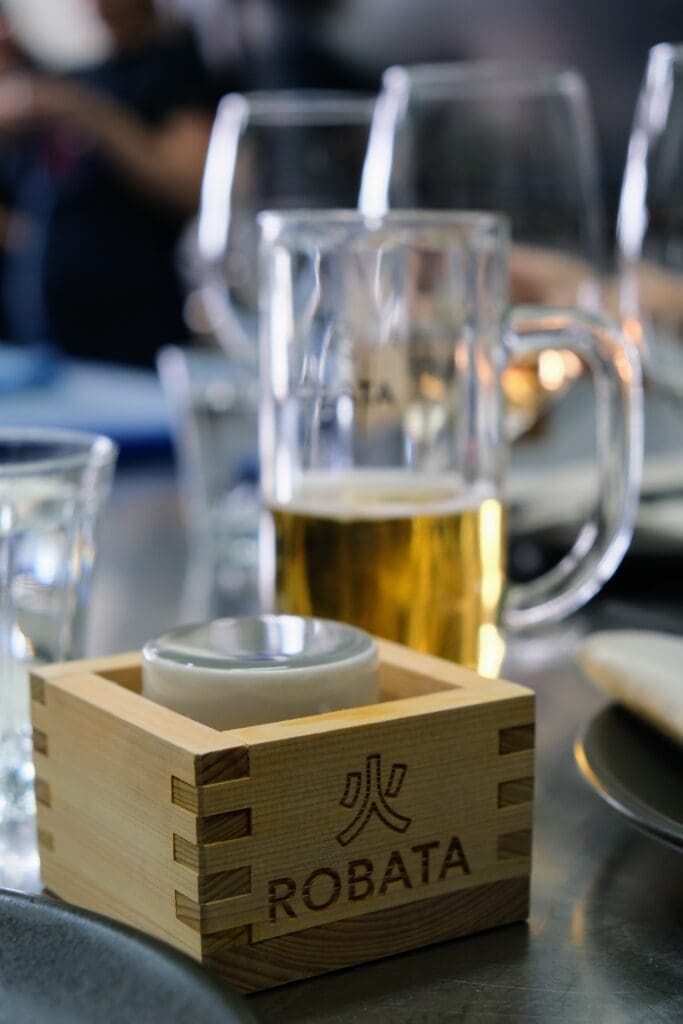
Tokusen Teinoudo Junmai sake has a rice polishing rate of 70%, expressed as the percentage of rice grain left after polishing away the outer layers. The more that is polished away, the lighter bodied, and the more delicate, fruity or floral flavours can come through. At 70%, Junmai sake typically retains more earthy cereal and rice flavours, with a touch of minerality and a fuller body. Due to the higher acidity and fuller-bodied flavour, this Junmai sake can stand up to more robust flavoured foods, including hotpot and tsukemono (pickles).
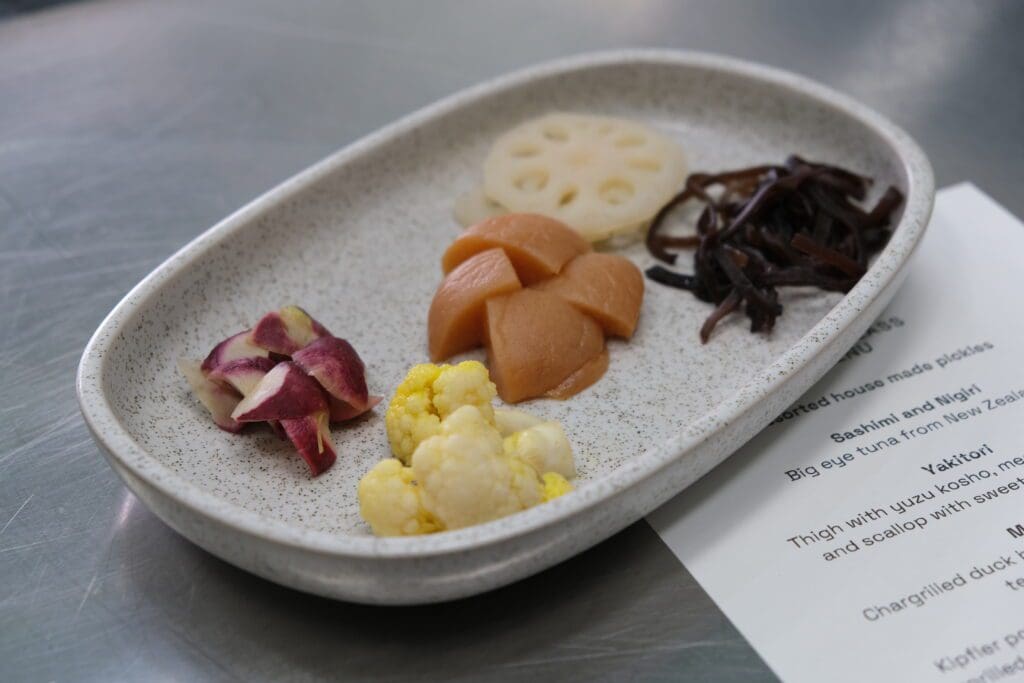
And that afternoon, we enjoyed it with various pickles already waiting for us on the table. There were radish, lemon, cauliflower, lotus root and shredded mushroom pickles.
Japanese Knives
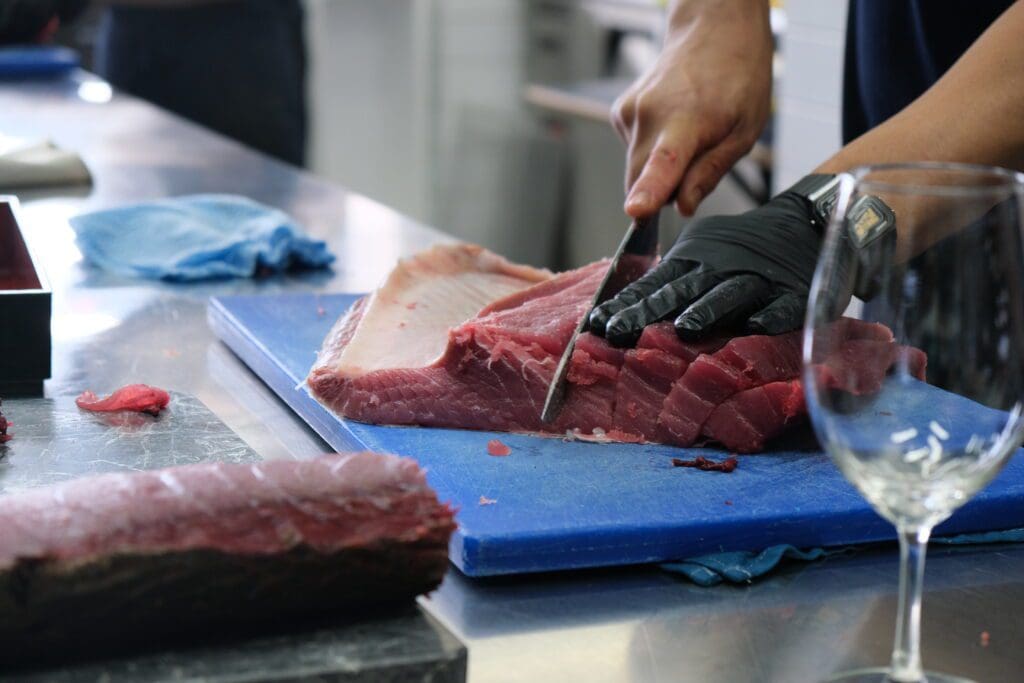
The first lesson in the Japanese cooking masterclass was the chef’s knives, which, aside from the sashimi knife, seemed all too confusing for me.
The tuna for the day was the Big Eye Tuna. It flew in all the way from New Zealand and then dried in the fridge for 5-6 days.
Maguro Sashimi
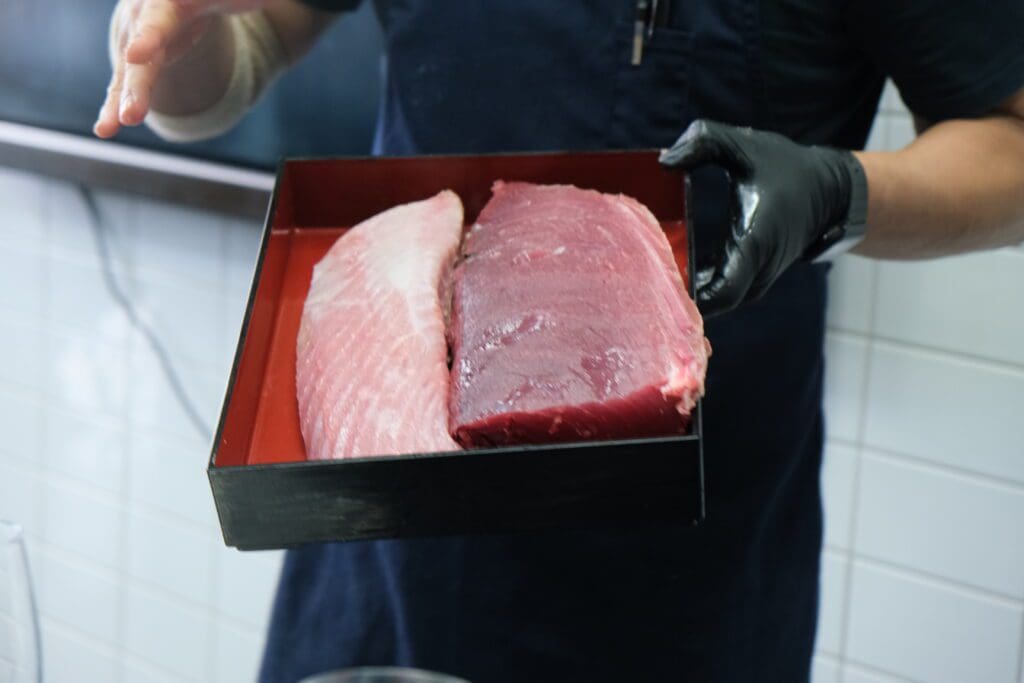
Chef Yosuke taught us how to cut it and, more importantly, the different parts of tuna ━ from the reddest part, the well-loved Toro (fatty tuna belly), to the pinkest part. He reminded us that each tuna is different and to plan to cut it to minimize the waste.
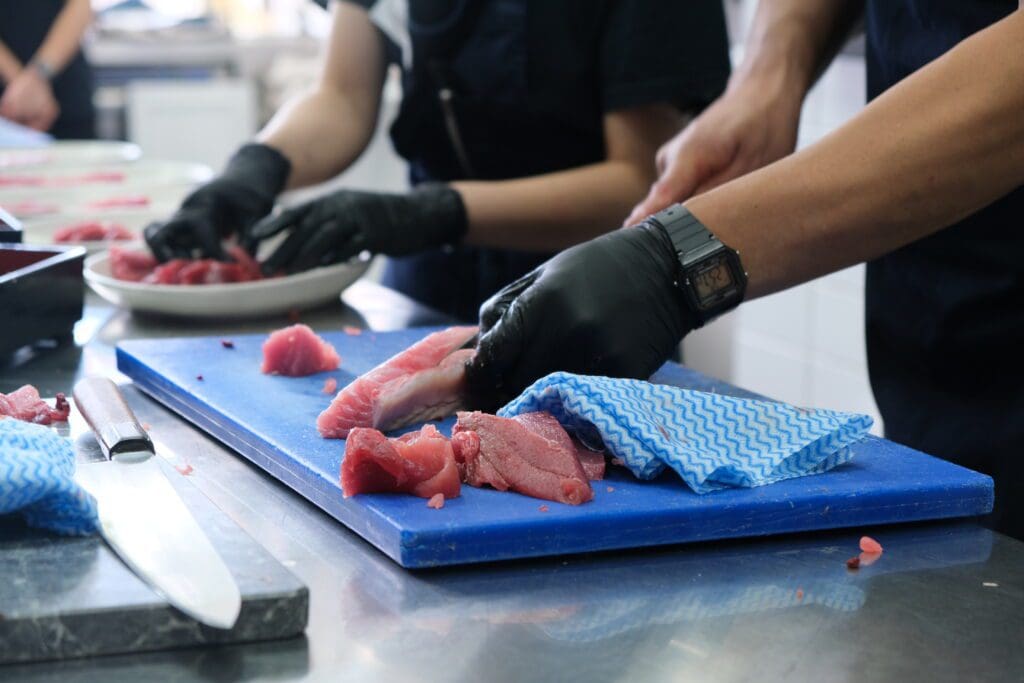
He then taught us the slicing technique using four fingers as a measurement and proceeded to slice big chunks of tuna sashimi ━ in three different colours before serving it on the plates. Around the same time, Gemma poured the second sake into the wine glass.
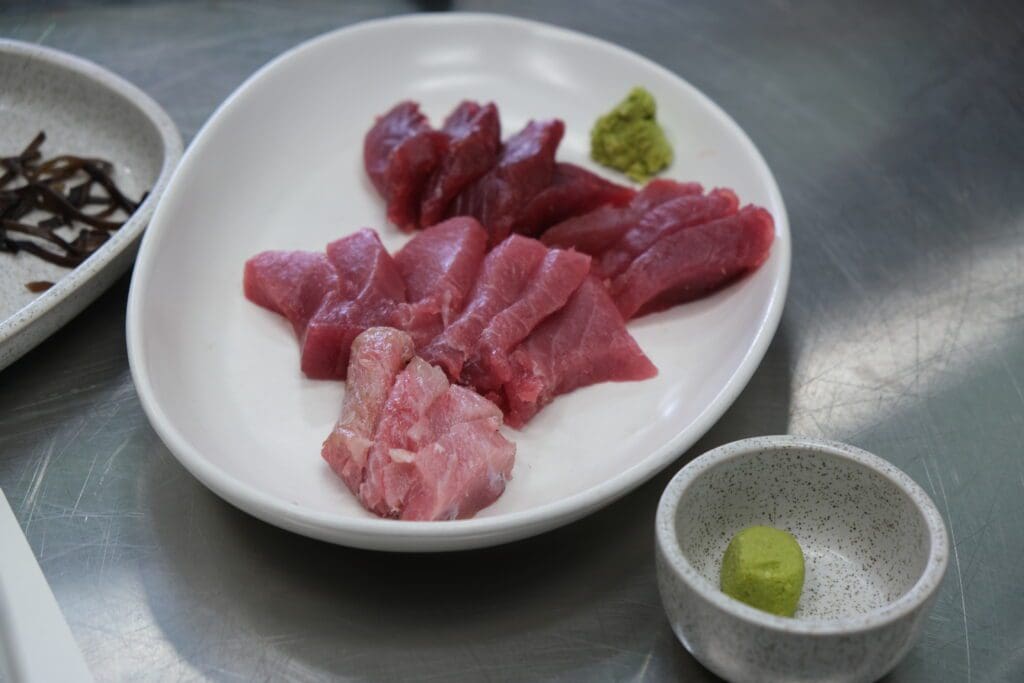
‘White’ Junmai Ginjo sake
Jozen, ‘White’ Junmai Ginjo sake, uses locally grown Gohyakumangoku rice, polished to 60%. The Toji aimed to create a sake that was simple, soft, and as easy to drink as the purest water used to make it so that it could be enjoyed by those new to sake or those who had previously thought they did not enjoy it. Typical of a Ginjo sake, it has a light fruitiness, hints of apple and pear, and a short, soft finish.
This sake is perfect for pairing with lighter dishes such as sashimi and sushi, as it gently cleanses the palate between bites. It can also be paired with sweet dishes, especially fruits. It is best enjoyed chilled in a wine glass to appreciate the delicate aromatics.
This sake is a product of Jozen Mizunogotoshi, located in Echigo Yuzawa, in the foothills of Niigata prefecture, a mountainous region with high snowfall. It has some of the softest snowmelt groundwater in Japan and is the largest rice-producing area.
The current Toji (Master Brewer) at Shirataki, Takaki Matsumoto, has been at the brewery since high school, working his way up from the bottling team to his current position, and has created numerous award-winning sakes during his time.
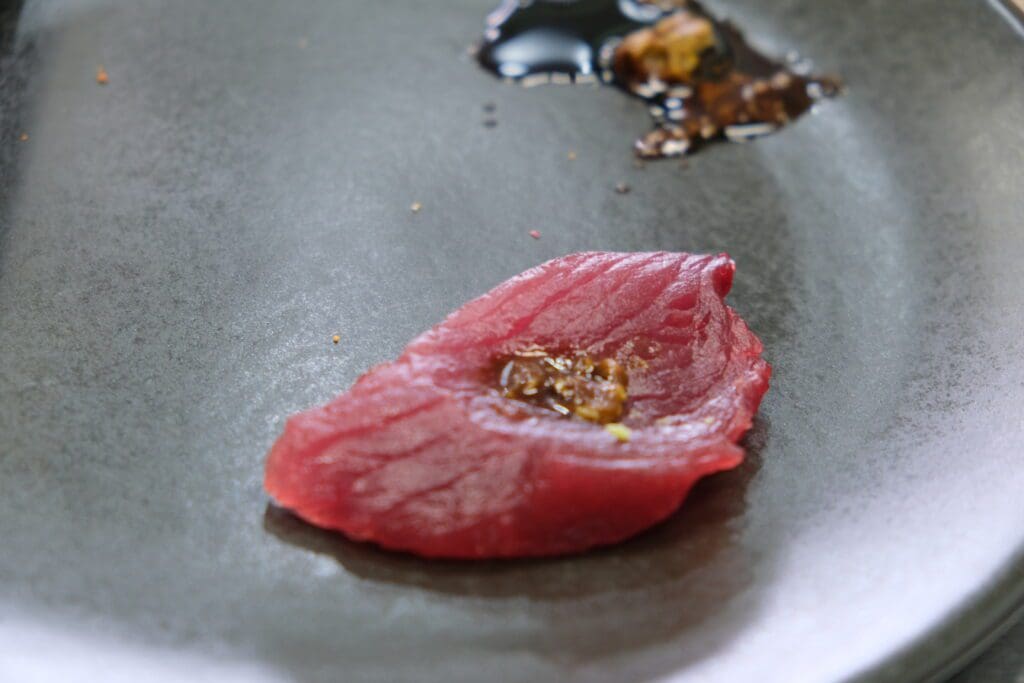
Japanese Cooking Masterclass on Maguro (Tuna) Nigiri
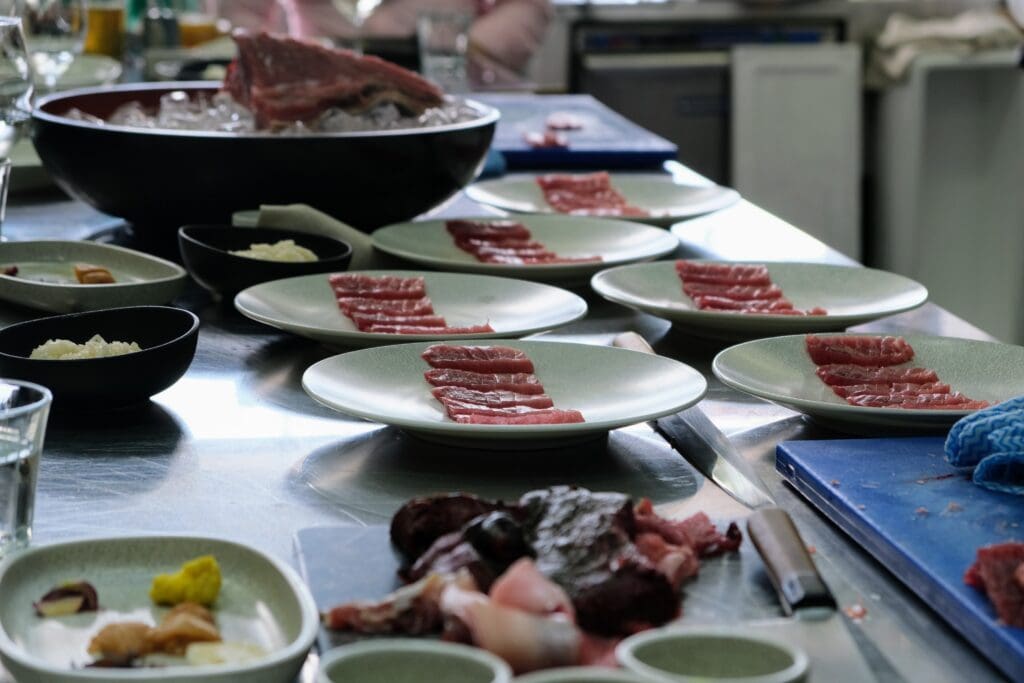
The next on the Japanese cooking masterclass syllabus is making nigiri ━ tuna nigiri, to be exact. The chef put thinly sliced tuna meat (each thicker on one side) on plates before demonstrating the method.
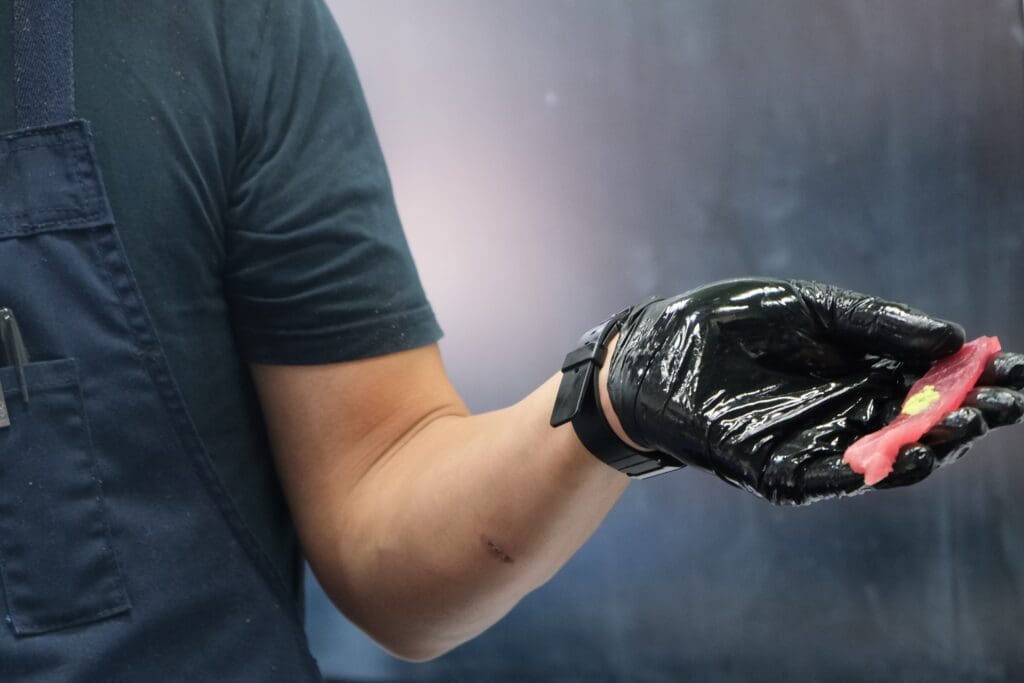
First, put the sliced tuna in one hand. Next, place a tiny bit of wasabi on the thicker part of the slice.
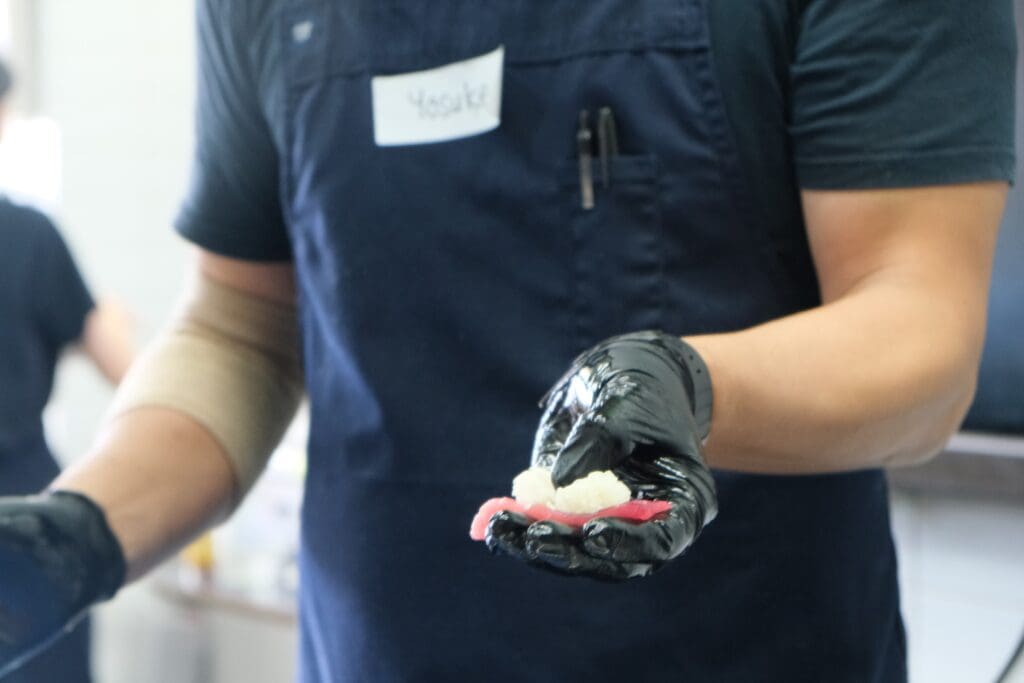
Then take some rice and make it into a bowl, but not too tight as it needs to be fluffy and airy. Next, put the rice bowl in the middle of the tuna, press the centre of it with a finger and flip it to the other hand.
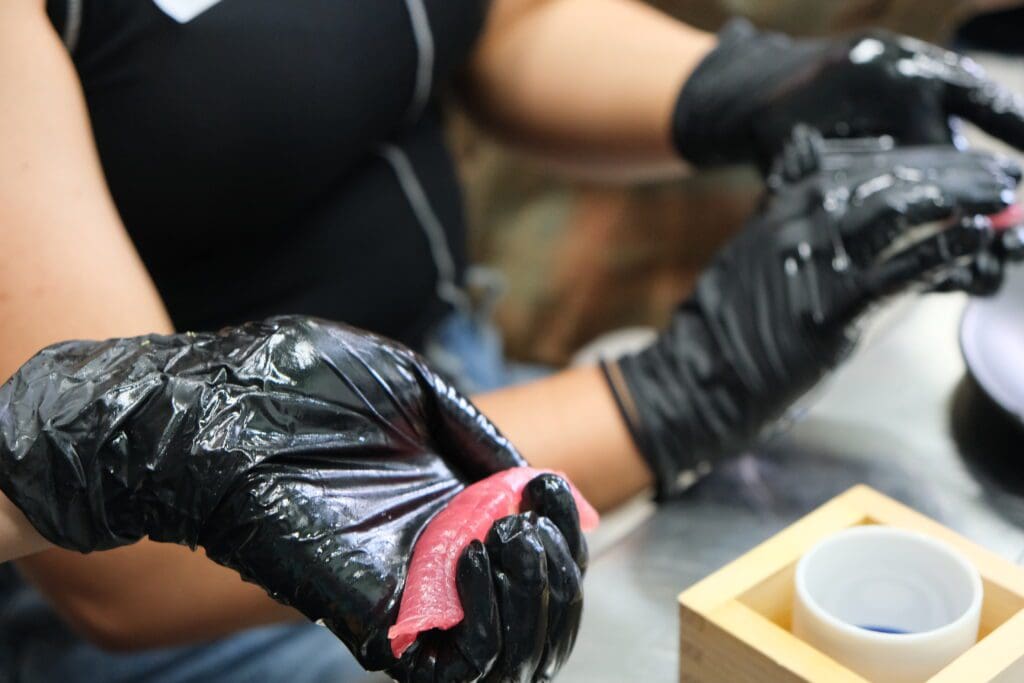
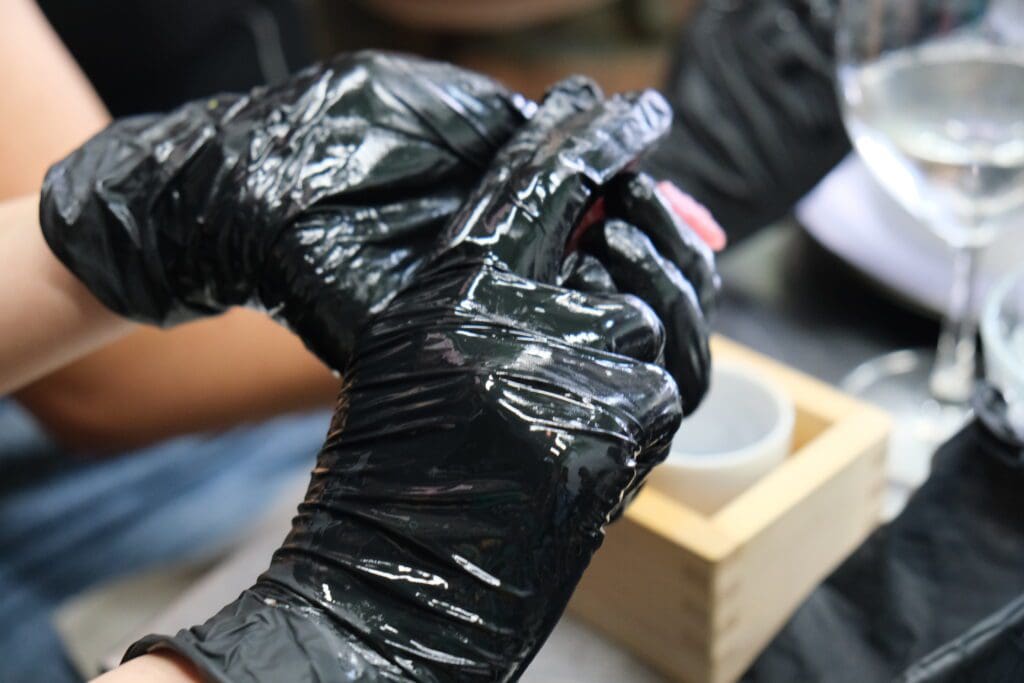
Now, using two fingers, shape the nigiri like a boat.
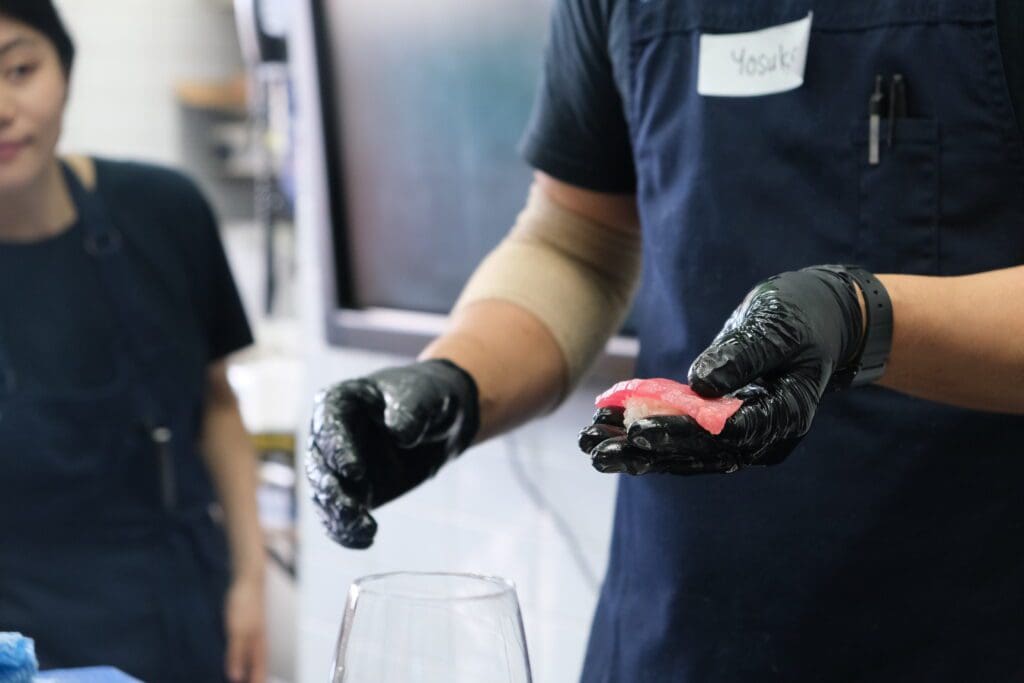
Keep trying until it looks like the ones served in the sushi train restaurants.
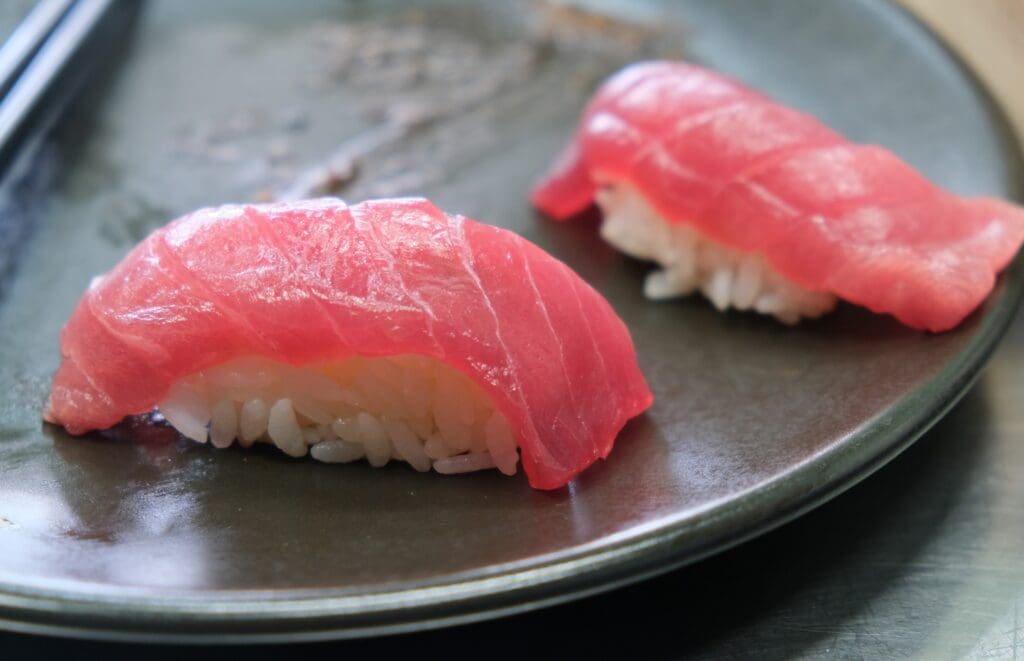
This part was really fun! Unfortunately, by then, it was already 3.30 PM, the ending time of the Japanese cooking master class based on the booking. I was ready to pack up, but apparently, only the class part was done, not the experience.
A Feast at the end of Japanese Cooking Masterclass
We were invited back to Robata Melbourne restaurant and served beautiful set meals.
Yakitori
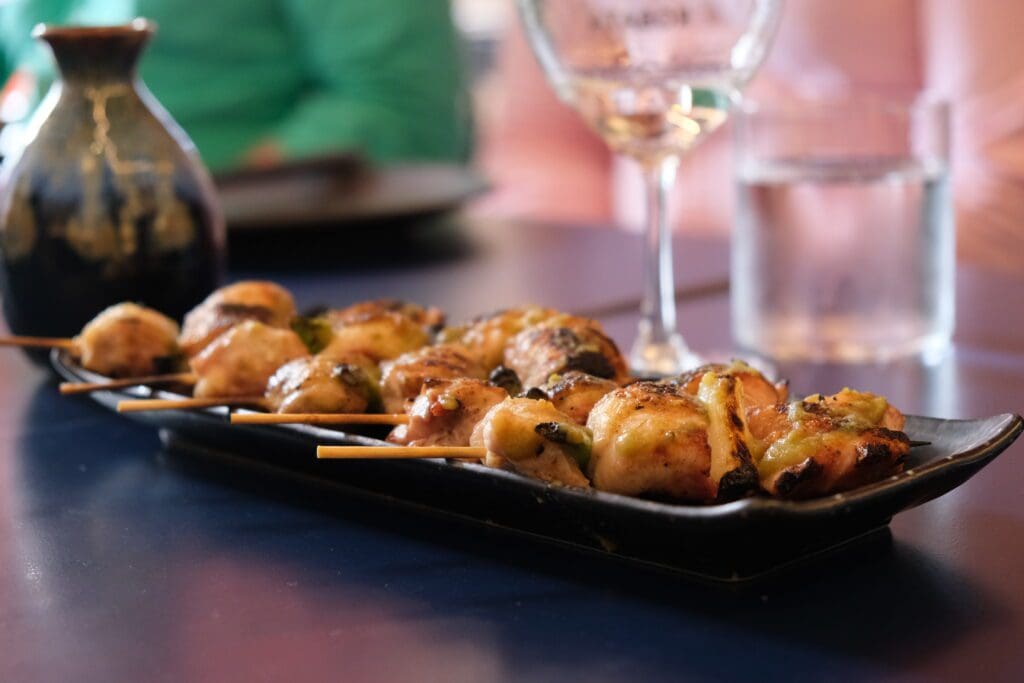
First come three plates of yakitori ━ all grilled on the renowned Japanese hibachi grill. The chicken yakitori was glazed with Yuzu Kosho. Yuzu Kosho is a Japanese condiment made from fermented chilli, salt and juice from yuzu fruit. This yakitori would easily be Fafa’s fave had he joined me in this Japanese cooking masterclass.
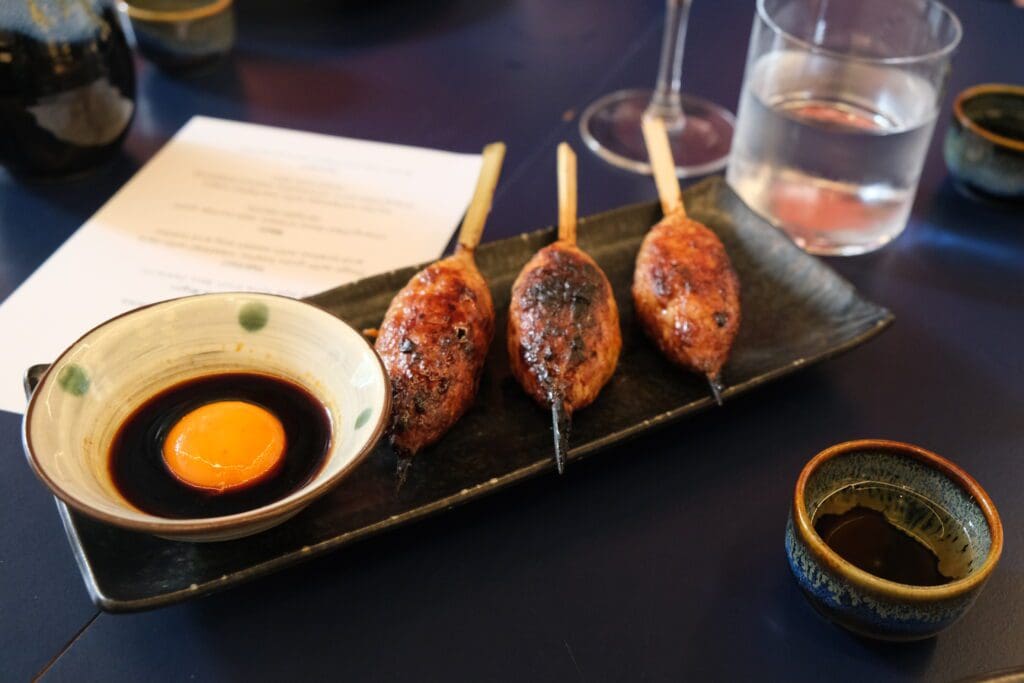
My favourite was the meatball yakitori served with a side of tare sauce with a raw egg floating on it.
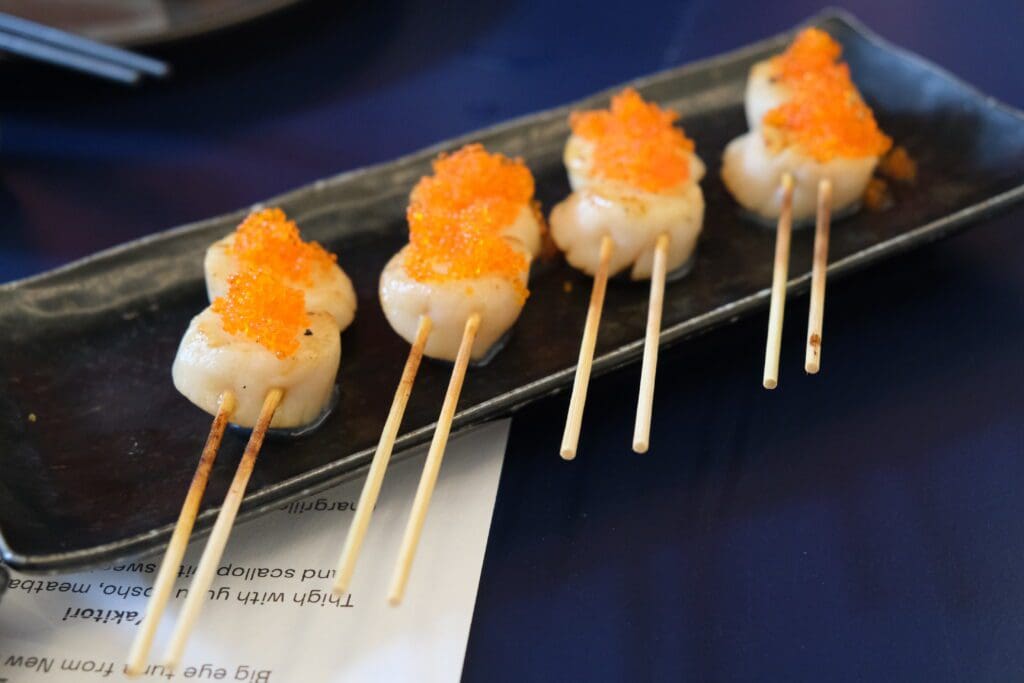
Equally as good was the third yakitori, scallops topped with tobiko served on a bed of sweet soy sauce.
Tengumai Yamahai Jikomi Junmai Sake
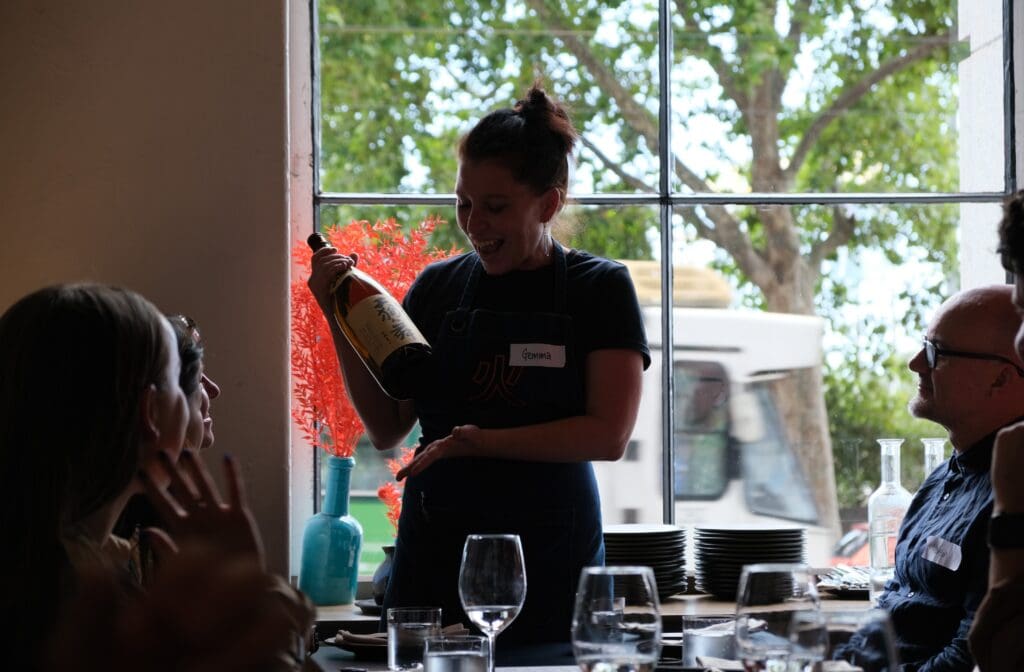
Around the same time, Gemma started serving us the final sake of the day, Tengumai Yamahai Jikomi Junmai. This sake uses Gohyakumangoku rice, the second most favoured sake rice after Yamadanishiki.
Shata Shuzo, the company that produces the sake, does not use charcoal filtration, which allows more of the rice’s natural golden colour and flavour to come through, as well as using the more labour-intensive Yamahai Jikomi method, which tends to have pronounced earthy, spicy flavours and a golden colour. This sake is also tank aged for more than 12 months before bottling, adding complexity to the palate and a long finish.
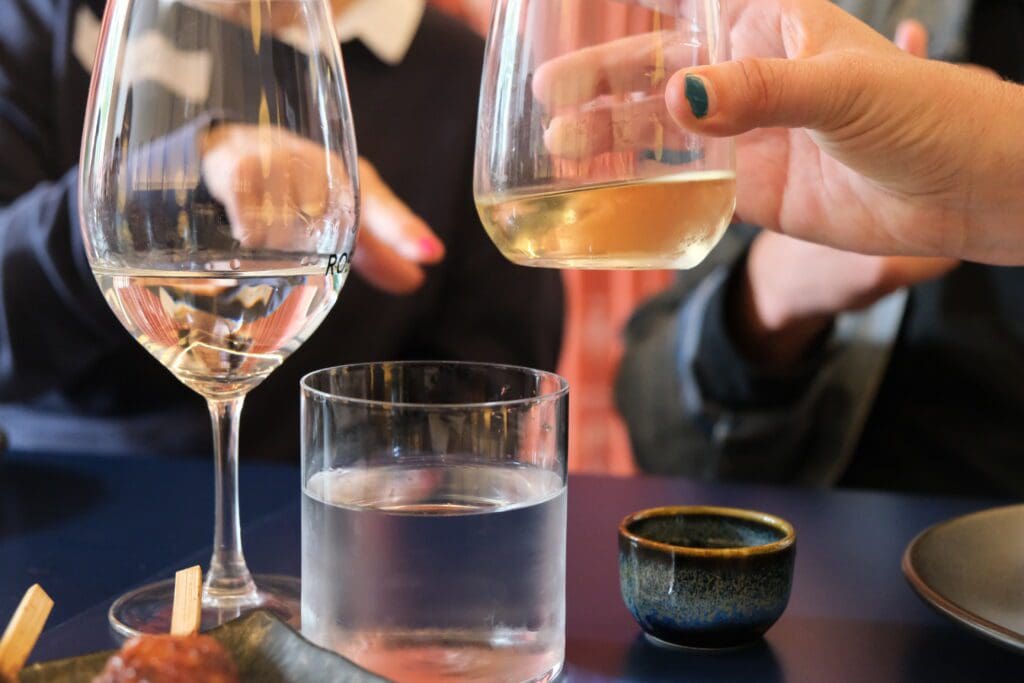
This sake pairs well with grilled meats, fish, and stronger-flavoured dishes using soy sauce and miso. It can also be enjoyed warm or at room temperature, which is how it was served in the Tokkori (sake carafe) that day.
Main Course
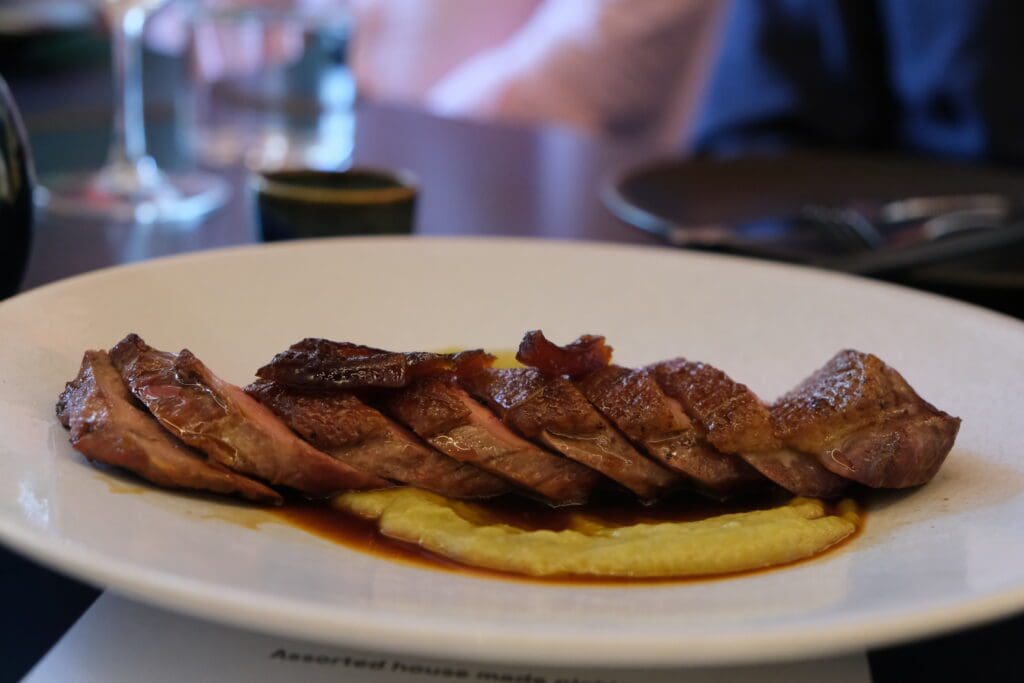
The star of the sit-down meal was chargrilled duck breast served with leek puree and yuzu teriyaki sauce. I had never had anything like it before, and I couldn’t stop thinking about it ever since. It was heavenly.
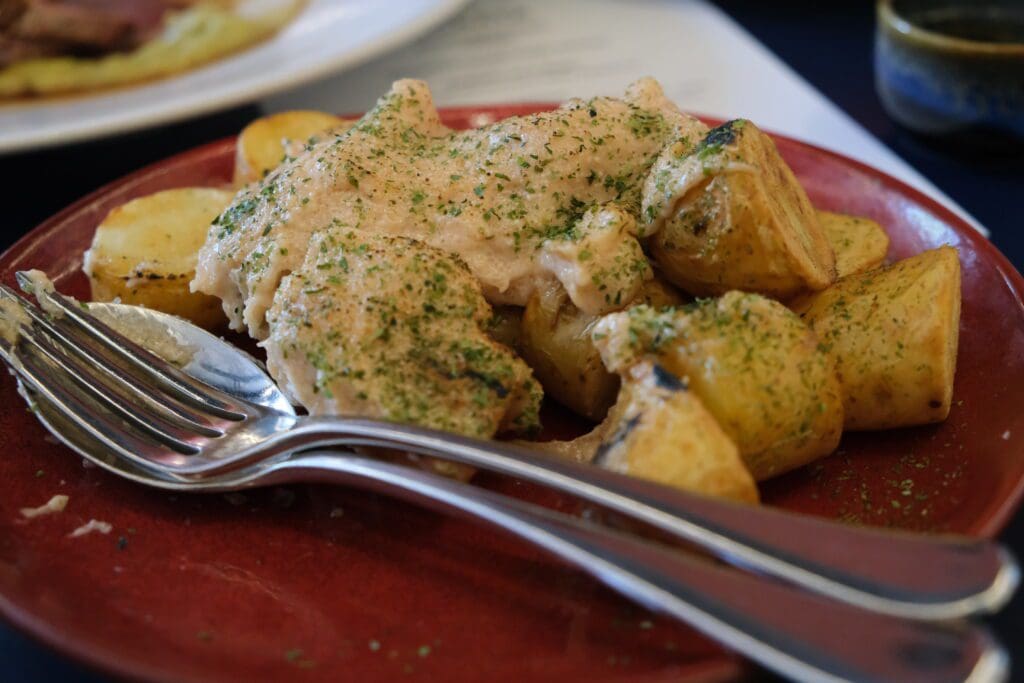
Then came a plate of Kipfier potatoes with Mentaiko mayo. The mayo sauce was really good. I could see myself putting a generous dollop on top of fried vegetables to elevate the palette.
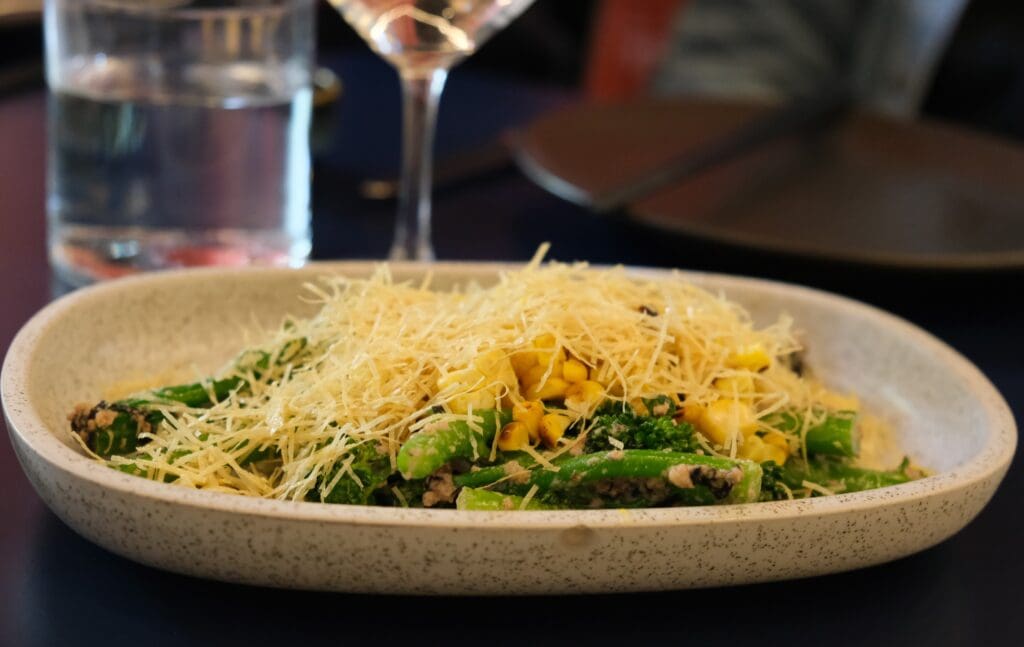
Speaking of the vegetables, the next plate was a plate of Broccolini with chargrilled corn drizzled with walnut dressing and topped with shredded tofu skin. It was delicious, but everyone at the table was curious about the shredded tofu skin. So how did they make it??
With the last sake kicking in, the “classmates” started to let loose, and the discussion moved from the shredded tofu skin to other things. We talked about your families, gears (mainly my camera) and our food obsession. No surprises on the last point; none takes a Japanese cooking masterclass if they are not obsessed with food.
Drunk and Delicious Dessert
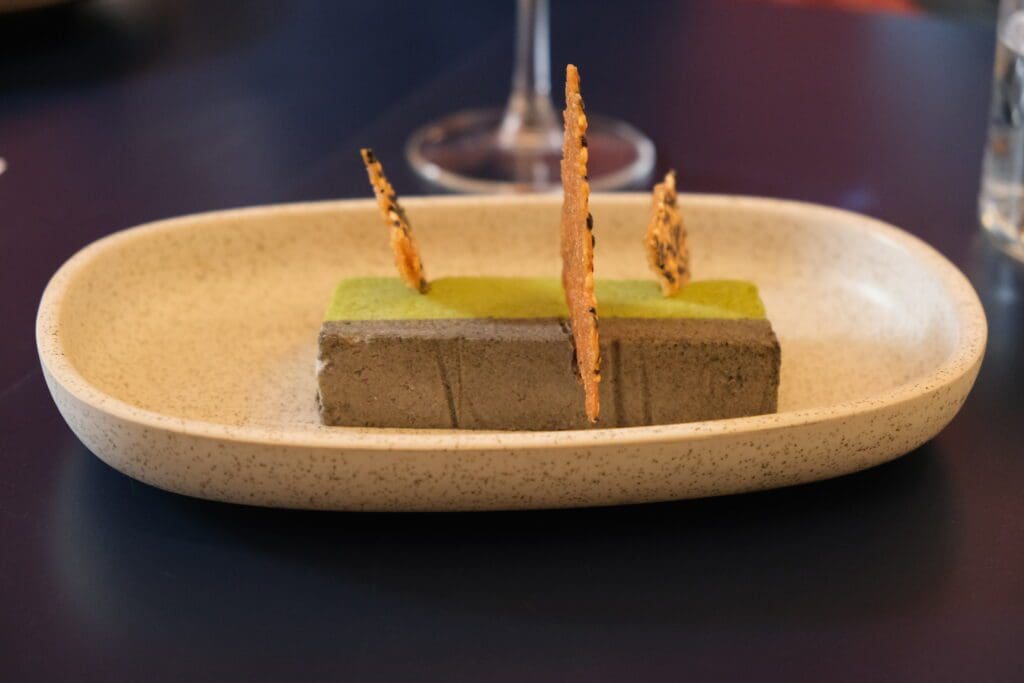
The final course was the dessert, Green Tea and Black Sesame Parfait. It was a typical Asian dessert, not too sweet and hit the right spot— the perfect ending for a banquet-like feast.
On top of all these, we were sent off a goodie bag with different robata brand products inside. It was a jar of Miso Mustard, which I can’t wait to use when I make grilled salmon next.
I told my classmates for the day that I had to rush as Fafa was waiting for me to have dinner in less than an hour. So we ended up cancelling the dinner plan, which was a good call because I was too full and happily drunk to eat anything for the rest of the day.
Robata Japanese cooking masterclass happens only once in a blue moon, so if you are keen, subscribe to their newsletter and immediately book a spot when there is an opening.
Ps. I got a $50 gift voucher to be used in Robata when I booked the Japanese cooking masterclass.
Pps. I got details of the sake and pairing from Robate Melbourne’s sake-tasting notes.
Ppps. Follow me on Instagram @KultureKween for more recent updates.
